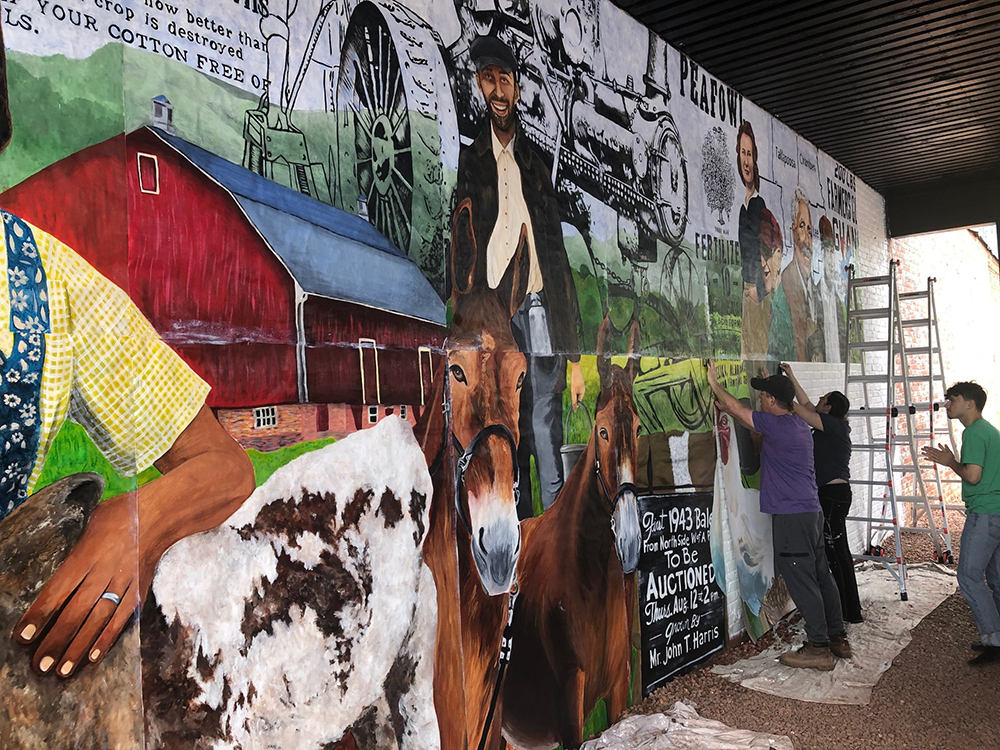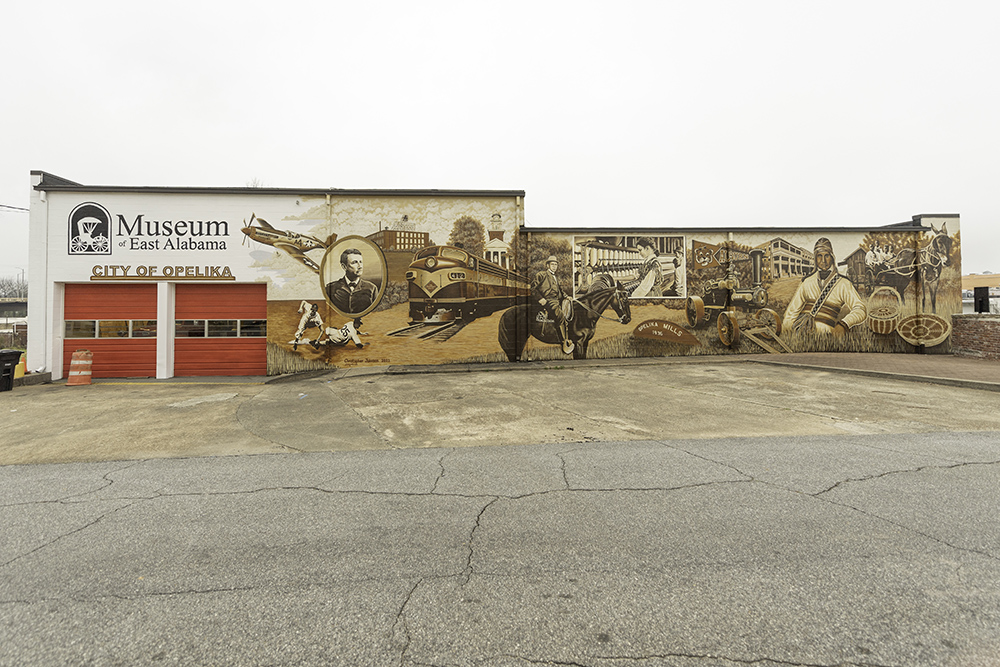By Ann Cipperly
For the Observer
OPELIKA —
After the completion of two murals and a pavilion to house the 1904 Case steam tractor “Old Nancy,” the Museum of East Alabama is hosting a dedication and reception Thursday, May 12, from 4 p.m. until 6 p.m. The Opelika Chamber of Commerce will conduct two ribbon cuttings for the dedication.
After the ribbon cuttings and dedication, a reception will be held in the museum. Hearty appetizers and desserts will be served, along with wine and other beverages.
The public is invited to attend the dedication and reception and to browse the exhibits on both levels of the museum, which focus on the history of the area, as well as agriculture and industry.
After mural artist Christoph Johnson completed a vibrant postcard-style mural for the new Opelika Public Library, board member Ginger Stern contacted him about a mural project for the museum. Johnson met with the board to discuss the mural design illustrating the history of East Alabama.

The artist met with Glenn Buxton, the museum director, to discuss the history of the area and view exhibits in the museum displaying the unfolding events in the railroad town. Notable figures were also featured, including Gov. Samford, Creek Indian Chief Micco, Booker T. Washington and Tuskegee Airmen.
The result was a stunning mural on the side of the museum facing Avenue A which also included historic sites, Pepperell Mill, the courthouse and much more.
Johnson used a sepia color palette to unify all the elements in the mural while offering a touch of nostalgia. He said he was a little concerned that the sepia color would not go over well with board members, but they all approved the sepia color and design.
“I am very proud of the way the mural at the Museum of East Alabama turned out,” Johnson said. “The result has become one of my favorite murals that I have ever painted.”
On April 5, Johnson was honored by the mayor of Opelika for his artistic contributions to the city, which included the mural he painted for the new library. Johnson was awarded an official proclamation by the city of Opelika.
The second mural at the museum was sponsored by Pebble Hill Center for Arts and Humanities and the Department of Art and Art History at Auburn University. The class was led by Wendy Deschene, professor of Art in Painting and Drawing in the Department of Art and Art History.
Deschene and her classes have been painting large-scale murals for the community for almost 16 years. She has included a mural assignment in her painting classes since 2006, when she was first hired by Auburn University.
“As a result, the painting department is one of the area’s longest and most consistent creators of murals in this area,” Deschene said. “We have created dozens of community projects on campus and off.”
This is the second time the Department of Art and Art History has dedicated an entire class section to mural painting instead of just placing it as an assignment in part of a painting class.
“The logistics of getting our students to sites between classes they have to take on campus have been difficult to solve,” Deschene said. “But using canvas or mural cloth has allowed us the opportunity to stay on campus and get bigger and bigger.”
The class’s new 35-by-13-foot design was placed alongside the Old Nancy exhibit.
“As a result, our new mural concentrated on celebrating agriculture in the area,” Deschene said. “It showcases old equipment and fertilizer advertising, influential local agricultural pioneers, the landscape and hardworking farmers and the farm culture of the area.
“We had seen photos of the tractor Old Nancy, so we took the color scheme from the tractor, which was black, green and red. The resulting mural used that color scheme to complement the overall feeling of the exhibit.”
Two figures depicted in the mural are George Washington Carver, an agricultural scientist and inventor, and Booker T. Whatley, a professor at Tuskegee University and one of the pioneers of sustainable agriculture in the post-World War II era.
Deschene expressed thanks to Mark Wilson from Pebble Hill and the Breeden Scholarship Committee for believing and supporting this project.
“This project would not have been possible without his office understanding our abilities or what we needed,” she said. “It’s the biggest project we have completed in a semester. This success is partly because other AU collaborators so fully supported it.”
The Old Nancy tractor was originally purchased for use in a sawmill in Lee County. The engine arrived in Opelika by train and was driven to its home south of Beauregard. The tractor was named in honor of the steam railway locomotive, “Nancy Hanks,” who operated on the line between Atlanta and Columbus, Georgia. She served two generations, providing power for the sawmill.
In 1954, the engine was driven in the Opelika Centennial parade. On July 4 in 1956 and 1957, “Nancy” was operated as part of the Independence Day celebrations.
The tractor was designated a significant landmark and placed on the Alabama Register of Landmarks and Heritage by the Alabama Historical Commission in 1978.
Old Nancy had been on loan to Auburn University for more than four decades. It now has a new home at the Museum of East Alabama. The Old Nancy tractor was donated by the Charles Whatley family.
“I hope everyone will come out and join the celebration of our history when we dedicate the murals and Old Nancy,” said Jim Hardin, president of the museum board. “The event is free, and we will have something for all ages. Come join us and see the progress at the museum.”
The Museum of East Alabama is located at 121 South 9th St. in downtown Opelika.


